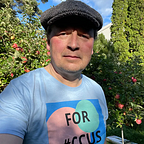Unique Sensor Technology — From Kuopio to the World
Kuopio has its’ Puijo tower* rising over the whole city and surroundings. Three hundred six meters above sea level, it is an imposing landmark in the region, and the sights from the top are amazing. Erected in 1963, the history of towers at Puijo goes far back to the mid-1800s. During those historical times of Finnish nation-building, Kuopio was also part of the growing awareness that marked the path for independence. In those times of transition, my great-great-great grandfather’s family were the ones who initiated and led the building of the first wooden tower at this place in the mid-1850s.
Now, with ROCSOLE**, we are not building towers. Still, our sensor solution profilers installed inside separators with a top body flange resemble a tower structure. Our profilers generate frequent data to enable level measurements in various matter and liquids, especially under dirty (contaminated) and harsh operating conditions. We are also making our marks on Kuopio and the world.
In our own “Iron Maiden” test vessel located in our Kuopio Lab (K-Lab) we can perform technology readiness level 3 and 4 tests; for our own purpose of refining, tuning and learning for improving our software and data interpretation; and for customers to qualify and test new potential applications. In the above picture you can see the profiler in a sand-water-gas (air) system, which is monitored in real-time with operator visualization on the screen (not shown here).
Profilers are used in vessels such as multiphase gravity separators, which you cannot visually monitor and inspect during operations. It means that robust and reliable sensors are critical. Now, you might think, does not this type of technology and solution already exist? The answer is yes. However, incumbent solutions are out of several reasons, not robust enough, nor provide the reliable insights required in today’s type of operations.
In the oil and gas industry, separators enable phase separation and provide a good product quality — gas, oil, water, and any solids need to be separated. All this might sound easy, but there are a variety of waste and contaminants in the wellstream flow to facilities, and the high watercuts are causing a blending of oil and water into stable emulsions. Level instrumentation is the most common cause for separator failures, as all the complexity in processing causes them to be unreliable and malfunction.
Our crucial target is to remove this massive pain point and bottleneck for operations and our customers. For a very long time, this has not been possible to correct. Operational data for emulsions is generated from manual bottle sampling. But it is time to change this, disrupt the industry, and make it safer, more efficient, and cleaner by reducing emissions and pollution.
Problems are not just of a technical kind; management lacking data or only having manual data leads to dangerous run-to-failure situations and unplanned shutdowns. One relief system is the flaring, causing massive additional carbon emissions. Some industry facts: 75% of US Gulf Coast maintenance for the processing industry is unplanned. One hundred fifty-four refineries in North America have more than 2,000 unplanned yearly stops causing toxic pollution equivalent to more than 2,000 years of regular production. We need to stop this.
Based on our electrical tomography, made robust and reliable for industrial processes, it is applied to generate the “must-haves,” like the crucial interface levels, but also unique insights for troubleshooting and detailed debottlenecking. Now you can build AI decision tools, another fascinating area creating additional user value.
Our proprietary sensors and software application areas go far beyond oil and gas processing. A similar type of operational issue is all around industries. Digitalization and decarbonization go hand in hand. One key measure is to generate actionable insights from critical processes that are mostly handled with manual work operations or limited data.
30% of total carbon emissions come from the manufacturing industry. We are not leaving them out. There are many applications where our world-leading technology can dust out the insights to take efficiencies to the next level.
/Mika
*want to learn more about the Puijo tower: https://www.puijopeak.fi/en/puijo-tower/
**want to learn more about Rocsole: www.rocsole.com
